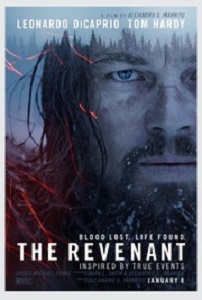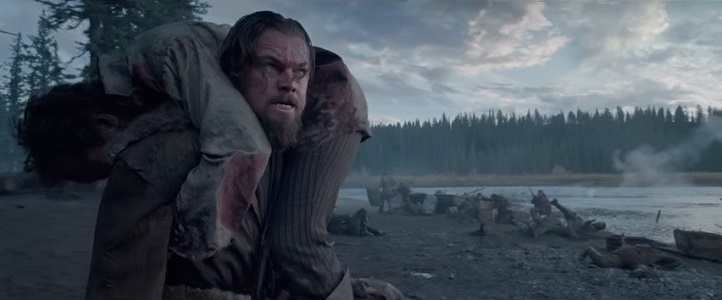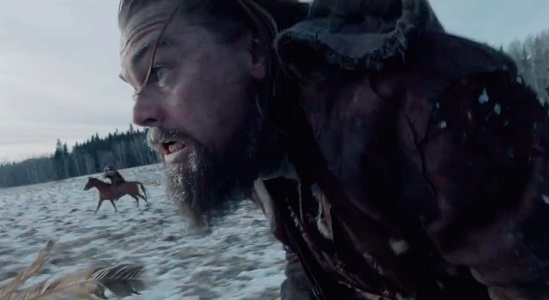Inspired by true events, ‘The Revenant’ captures one man’s epic adventure of survival and the extraordinary power of the human spirit. In an expedition of the uncharted American wilderness, legendary explorer Hugh Glass (Leonardo DiCaprio) is brutally attacked by a bear and left for dead by members of his own hunting team. In a quest to survive, Glass endures unimaginable grief as well as the betrayal of his confidant John Fitzgerald (Tom Hardy). Guided by sheer will and the love of his family, Glass must navigate a vicious winter in a relentless pursuit to live and find redemption. (Synopsis by 20th Century Fox)
Revenant (n.) – A person who has returned, especially supposedly from the dead
Let’s get right to it. “The Revenant” is the best Western so far this century, and could mark a comeback for the whole genre. If you consider yourself a fan of movies and that statement doesn’t get you excited, just hear me out.
Those who see it are in for a brutal journey – and I’m not just talking about the story itself. Make a quick Google search and you’ll find fascinating, if somewhat troubling anecdotes about its production. At one point, for example, co-star Tom Hardy came to blows with director Alejandro Iñáritu over a lack of safety measures being taken for the actors. Iñáritu responded glibly the next day with a picture cake commemorating their altercation.
Meanwhile, Leonardo DiCaprio – who is a strict vegetarian – voluntarily bit into a live fish, and ingested part of a raw bison liver. As if the A-lister’s performance weren’t remarkable enough, such uninhibited commitment goes beyond demonstrating passion or professionalism. This is a man who is clearly willing to do almost anything to himself for the sake of art. Now, you can claim that going to such lengths wasn’t necessary, and you’re probably right. We know that Hollywood is capable of faking much more impressive feats. But knowing that he did go to such lengths adds an intangible credit to the movie’s already powerful sense of realism.
True to point, “The Revenant” is one of those rare movies wherein art and reality somehow manage to collaborate so well that it’s almost blissful. The chronological shooting schedule had to be lengthened several times because Iñáritu was insistent on using only natural light, and filming in this way makes maintaining continuity incredibly difficult. But make no mistake, the effort was well worth it.
Like in the great Westers of old by John Ford and Sergio Leone, the landscape here plays just as big a role as any of the characters – and it is gorgeous. Almost every shot exposes nature’s naked splendor. But such unfiltered beauty is nevertheless complemented by an air of latent perilousness rarely captured on film. Iñáritu’s depiction of the wilderness doesn’t convey any deliberate malice towards man, but shows, rather, just how indifferent it is to his plights – and those plights go far beyond coping with the elements.
A prevailing motif throughout the film is the protection of families. DiCaprio’s Hugh Glass seeks revenge for the death of his son, an Arikara chief seeks to rescue his kidnapped daughter, and a lonely Pawnee man confesses to being the lone survivor of his wife and children. Even the bear that mauls Glass only does so to protect her cubs. But if there is a singular emotion driving the film’s story, it’s the feeling of loss. And it’s the various responses to that feeling, or the fear of it, which separate the different characters.
Indeed, the movie’s emphasis on authenticity suggests it’s these responses that reveal everyone’s true character. A group of French frontiersmen prove despicably ruthless toward others because they fear losing profits on their excursion. And the same goes for our central antagonist John Fitzgerald, played menacingly by Tom Hardy (as only Tom Hardy can). Between these men, as well as everyone else’s brutal efforts to survive, seek justice, or protect their interests, one assertion by the film seems distressingly true.
At one point we see a crude sign adorning the hanging corpse of a native that reads (in French), “We are all savages.” What is clearly a fair indictment of those who killed and arranged the body could also extend to describe nearly every character throughout the film. If humanity distinguishes itself from animals not by how refined its technology is, but with its humility towards a higher power and the sense of morality it bestows, then it’s fair to say that any action contradicting these traits is categorically “savage.” Not only does this at times include our sympathetic protagonist, but surely us as well.
The classic American Western is said to be defined by A) its reverence toward nature, and B) masculine men overcoming adversities through moral revelations. Untamed landscapes are thought to offer the freedom of building a new life and identity, where the faults of a man’s character can be purged and his potential fully realized. However, certain Westerns, such as Howard Hawke’s “Rio Bravo” and Sam Peckinpah’s “The Wild Bunch,” portrayed this free environment as a place where men go not to better themselves, but to reject morality’s limitations. At some point, the conflict between these two outlooks is what came to define the genre most, if not within any one particular film then in the fact that the distinction continues to this day.
21st century Westerns like 2007’s “3:10 to Yuma” and 2010’s “True Grit” have addressed this conflict admirably, but have failed to visually communicate the kind of profound affection for the West that watershed films like “Stagecoach” and “The Searchers” so rarely did. And while Quentin Tarantino’s “The Hateful Eight” picks up some of the slack in this regard, it gives no credence to the more redemptive sensibility of Ford’s era. But thanks to the uncompromising authenticity of Iñáritu’s majestic visual style and the eloquence of its “savage” narrative, “The Revenant” marks the return of the definitively great American Western. And that’s cause for celebration.






Great movie. Found it hard to move when it was over. Needs to be seen in a very large screen to do justice to the camera work.